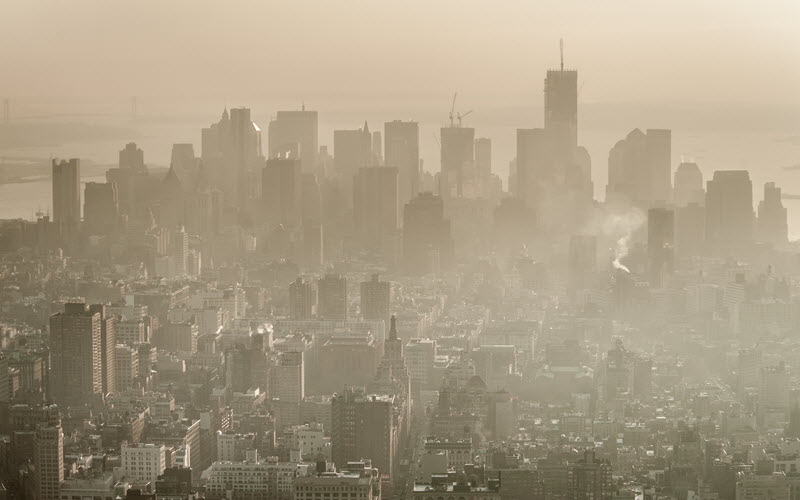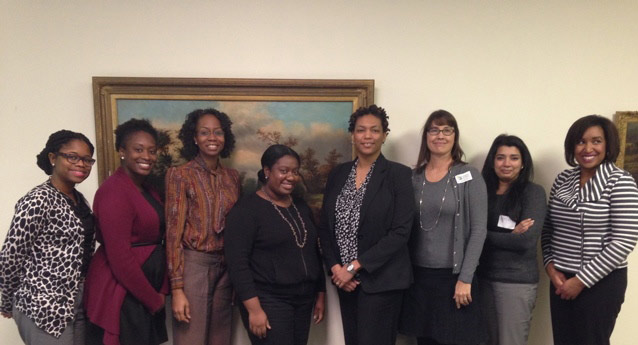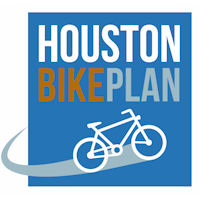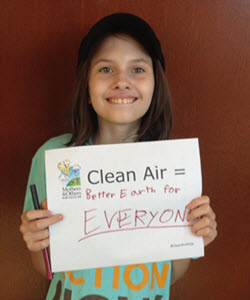Children’s health and well being are vulnerable to impacts of climate change related to extreme heat, increased air pollution, changes in food and water, changes in vectorborne diseases, and extreme weather such as flooding and wildfires. The Climate Change and Children’s Health Policy Roundup gathered stories of policy actions being taken by government and non-government groups to address such impacts, with the goals of creating a community of practice around children’s health and climate change and providing a resource of ideas, approaches, and lessons learned.
Around the country, recognition of the unique vulnerability of children is spurring policy actions and programs to protect children’s health against the impacts of climate change. These activities are happening at the federal, state, local, and tribal levels through both government and non-government efforts. The President’s Task Force on Environmental Health Risks and Safety Risks to Children gathers stories to highlight these policies and activities and to help build a community of practice around children’s health and climate change. The stories have been included in presentations at national public health meetings and shared through the Task Force mailing list. (Statements in the stories do not represent official views of the Task Force or any of its members).
Climate Change Is a Children’s Issue Resolution

California State Parent Teacher Association (PTA) Convention
For the first time, a PTA has officially declared climate change as a children’s health issue. In May 2015, delegates to the 2015 California State PTA Convention adopted a resolution Climate Change Is a Children's Issue. The resolution states that children represent a particularly vulnerable group already suffering disproportionately from both direct and indirect adverse health effects of climate change. By adopting this resolution, the PTA is putting climate change on the agenda of PTAs throughout California with the goal of mobilizing over 800,000 California PTA members.
The California State PTA will disseminate the resolution to every PTA in California. The resolution calls on PTAs to educate parents on the impacts of climate change on children’s health and future welfare. PTAs offer many ways to reach a wide cross-section of parents through regular PTA meetings, parent newsletters, and PTA Facebook pages. PTAs will be encouraged to build coalitions with other groups with similar goals. This resolution will also tie in with PTAs strong support for Safe Routes to School and PTA’s focus on children’s health issues. The resolution also calls on PTAs to urge school districts to develop climate action plans, and to educate students on climate, energy literacy, and human sustainability.
The resolution was written and submitted by the San Diego Unified Council of PTAs, one of the largest PTA councils in California. The San Diego parents believed it was vital that PTA, the largest volunteer advocacy association working exclusively on behalf of children, speak up for children who don’t have a voice. The San Diego team worked on the resolution for nearly two years with assistance from the American Academy of Pediatrics to assemble the research data required by PTA’s stringent resolution process. Now that the resolution has been adopted by the California State PTA, the next goal is to have it adopted by the National PTA, with nearly five million members nationwide.
Heat Illness Prevention School Project

Arizona Department of Health Services
The Heat Illness Prevention School Project is a toolkit created by the Arizona Department of Health Services in response to a CDC Morbidity & Mortality Weekly Report (MMWR) published in 2010. The report found that heat illness during practice or competition is a leading cause of death and disability among U.S. high school athletes (MMWR, 2010). In 2011, another MMWR also highlighted heat illness occurring at schools. The report discussed the importance of effective heat illness prevention messages. Messages should target all persons who are physically active. This population includes those who participate in unstructured sports and recreational activities. Within this group, teenagers ages 15-19 are at greatest risk for heat-related illness (MMWR, 2011). The goal of the toolkit is to educate students, school staff, athletic coaches, and parents regarding heat-related illness and prevention. The Heat Illness Prevention School Project aims to reduce the number of heat-related illnesses in schools.
Nurses for Cool and Healthy Homes
Fresno County Department of Public Health
Located in Central California with sweltering dry summers, Fresno County is among the poorest regions in the nation despite its rich agricultural productivity. This combination of low socioeconomic status with extremely high temperatures makes Fresno County residents, especially young children and the elderly, vulnerable to the health impacts of climate change.
The Fresno County Department of Public Health (FCDPH) hosts a variety of programs that offer home visits by nurses for families with babies and young children. Knowing this, Angela Wan, RN and Valerie Tran, MPH, MUP recognized that Fresno County would be the ideal setting for Nurses for Cool and Healthy Homes (1MB) (1MB) (NCHH), a program that aims to address the health impacts of climate change that Fresno County residents are already experiencing. With Wan’s background in nursing and the pair’s mutual interest in public health, the built environment, and climate change, the two developed this program while graduate students at the University of Michigan School of Public Health. In early 2014, Wan and Tran proposed this project for Health Care Without Harm’s Climate and Health contest for nurses. They were awarded the top prize of $10,000 to develop and implement the program.
In Tran’s previous work at FCDPH, she learned about the role and function of public health nurses in promoting maternal and child health. This knowledge informed the way in which NCHH aligns with the nurses’ scope of practice. By combining the latest scientific evidence on residential heat vulnerability with best practices for home environmental assessments, Wan and Tran developed a concise home environmental assessment checklist for the public health nurses to complete during home visits. Additionally, Wan and Tran collaborated with Pacific Gas & Electric Company (PG&E) to understand its customer assistance programs, including utility affordability and home energy improvement programs. They created a resource toolkit that helps public health nurses educate their clients and make appropriate referrals based on the home environmental assessment findings.
By partnering with the leadership at FDCPH, the pair helped the health department formally adopt NCHH and train over 30 public health nurses to address the health impacts of climate change through their daily practice. By institutionalizing NCHH, it is now the health department’s policy that all new home visit clients receive a home assessment with an emphasis on extreme heat safety, education on recommended resources, and a follow up to see if the client connected with the service. The program is collecting evaluation metrics on rates of clients found at risk, referrals made, clients connected to services, and more.
Although the public health nurses initially questioned the additional workload that NCHH would create for their busy home visits, they have found NCHH to be a concise, yet comprehensive toolkit to guide their conversations with clients about heat safety. NCHH brings climate change adaptation within the scope of practice of public health nurses who provide care to new moms and babies.
NYC Clean Heat

New York City Department of Environmental Protection
In an effort to reduce soot and fine particulate matter, New York City passed a regulation called the Clean Heat Program in 2011 to phase out the use of the dirtiest heating oils, heating oil #6 and heating oil #4. In New York City, 1% of the buildings produce 86% of the soot that contributes to air pollution. Air pollution is thought to contribute significantly to mortality and morbidity. According to a New York City health impact study, children had more than 2,400 emergency department visits annually for asthma that can be attributed to elevated PM2.5 levels. With climate change, air quality is projected to decrease with greater impacts on children. The new regulation encourages and assists building owners in converting to the cleanest available fuels. This policy disallows installation of new burners and boilers that use heating oil #6 or #4. It also requires that buildings using #6 or #4 boilers convert to cleaner alternatives over a three-year period.
NYC Cool Roofs

NYC Service and NYC Department of Buildings
In New York City, roof top temperatures can approach 190˚F on hot days, greatly contributing to the urban heat island effect. The Cool Roofs Program is designed to help building owners apply a reflective roof coating. This creates a cooler building that reduces cooling costs, energy demand, carbon emissions, and the urban heat island effect. Every 2,500 square feet of roof covered will reduce the city’s carbon dioxide emission by 1 ton. The policy also encourages children, via the Youth Volunteer Service, to help building owners cool their roofs and in turn promote awareness of climate change and civic engagement among youth. By continuing to fight climate change the Cool Roofs program helps to ensure a better future for New York City’s children.
Read the press release on the program to reduce energy usage and greenhouse gas emissions.
Advocacy Training for Pediatric Residents

Mothers and Others for Clean Air
Group photograph of the nine attendees at Morehouse School of Medicine’s training on climate change impacts on children’s health. Mothers and Others for Clean Air (M&O), a program of the American Lung Association of the Southeast, works to advance policies that improve air quality and fight climate change in order to protect children’s health. To achieve this, M&O partners with scientists and medical doctors, as well as parents of children with asthma or others with lung disease. To elevate the voices of medical professionals on the need to protect children’s health from air pollution and climate change, M&O partnered with Morehouse School of Medicine and provided advocacy training for their pediatric residents. M&O’s training covered air quality, climate change and children’s health, and skill-building in policy, media outreach, and serving as a spokesperson. M&O recruited all the doctors who attended and have been invited back to provide this training annually.
Biking and Complete Streets

City of Houston, Texas
The City of Houston committed to and invested in programs that decrease greenhouse gas (GHG) emissions, while providing children with safer ways to be active. The City passed a Safe Passing ordinance to keep bicyclists and pedestrians safer on city streets and encourage more outdoor activity, and expanded Houston BikeShare. In 2014, the City and BikeHouston joined forces to launch a major bike safety campaign, Goal Zero, to enforce and educate motorists and cyclists about the existing Safe Passing ordinance, as well as create a Bicycle Master Plan for the City.
The mayor also launched a transformative new approach for Houston streets that will accommodate the needs of all users, not just those behind the wheel: the Complete Streets and Transportation Plan is meant to provide safe, accessible, and convenient use by motorists, public transit riders, pedestrians, people of all abilities, and bicyclists. The ultimate goal, where appropriate, is walkable and bike-friendly neighborhoods with amenities such as trees and landscaping, public art, and street furniture. The City also launched Cigna Sunday Streets HTx on which streets are opened to bicyclists, pedestrians, families, etc. and closed to car traffic. And the City worked with the utility, CenterPoint, to allow hike and bike trails along utility rights of way. The rights of way provide a clear path of open space in Houston’s urban setting, and new trails will help create a complete network of off-street bicycle paths for Houston; Green Houston.
SPACE Units
City of Houston, Texas
The City of Houston has committed to and invested in programs that reduce cost, improve efficiencies, and decrease greenhouse gas (GHG) emissions, with benefits for both the environment and residents, including children. The City understands the need for clean, renewable energy is not only to improve the environment but also to offer more reliability during times of extreme weather events. Seventeen mobile solar-powered shipping containers/generators (SPACE units) were acquired through a partnership with the University of Houston’s School of Architecture’s Green Building Components Program and placed at fire stations, parks, neighborhood centers, and schools. The generators are designed for emergency relief efforts during hurricanes or as cooling centers during times of extreme heat. When not being used in an emergency, they are used year-round as outdoor classrooms to educate the public and bring awareness to solar projects. Read about this and more projects by Green Houston.
Working with The Weather Channel

Mothers and Others for Clean Air
In order to elevate the health impacts from climate change, Mothers and Others for Clean Air (M&O) work with that media to get the message out. Because stories are memorable and powerful, M&O always includes someone who is personally impacted. M&O identified Mikayla, a young teen with asthma, to share her story on what’s it’s like to have asthma and have to restrict her time playing outdoors when the air is unsafe to breathe with The Weather Channel. Laura Turner Seydel, M&O’s cofounder, was also interviewed for this story. Our goal was to amplify the connection between climate change and children’s health. Accomplishing our goal, the feature story ran several times on the The Weather Channel.
The Social and Economic Costs of Climate Change on Children’s Health
Children’s Environmental Health Network
Center for Environmental Policy at American University’s School of Public Affairs
Woodrow Wilson International Center for Scholars
The Children’s Environmental Health Network, with the Center for Environmental Policy at American University’s School of Public Affairs and the Woodrow Wilson International Center for Scholars, recently hosted a forum titled “The Social and Economic Costs of Climate Change on Children’s Health: What Do We Know and What Can We Do?” This forum brought together two panels of high-level experts to discuss how costs and health impacts of climate change will affect our children. Children are especially vulnerable to health effects of climate change, and it is vital that we think about how to best protect them and mitigate the effects of climate change for future generations.
The panelists provided their insights about the health impacts of climate change, possible mitigation strategies already in place, and strategies to come. Panelists included Dr. Patrick Breysse, Director of the National Center for Environmental Health and the Agency for Toxic Substances and Disease Registry, and Dr. Ruth Etzel, Director of Office of Children’s Health Protection at the EPA, who spoke respectively on initiatives that are already occurring in this realm, such as the National Environmental Public Health Tracking Program, and the EPA’s 5 Key Climate Actions. Dr. Sylvia Brandt, an economist from the University of Massachusetts Amherst, provided a case study showing how difficult it can be to truly quantify the cost of chronic diseases like asthma, and how these costs can increase due to climate change effects. As a positive conclusion to the forum, panelists agreed they were very optimistic about the youth movement around climate change, and felt youth voices would be key in the effort to protect children from the health effects of climate change.
